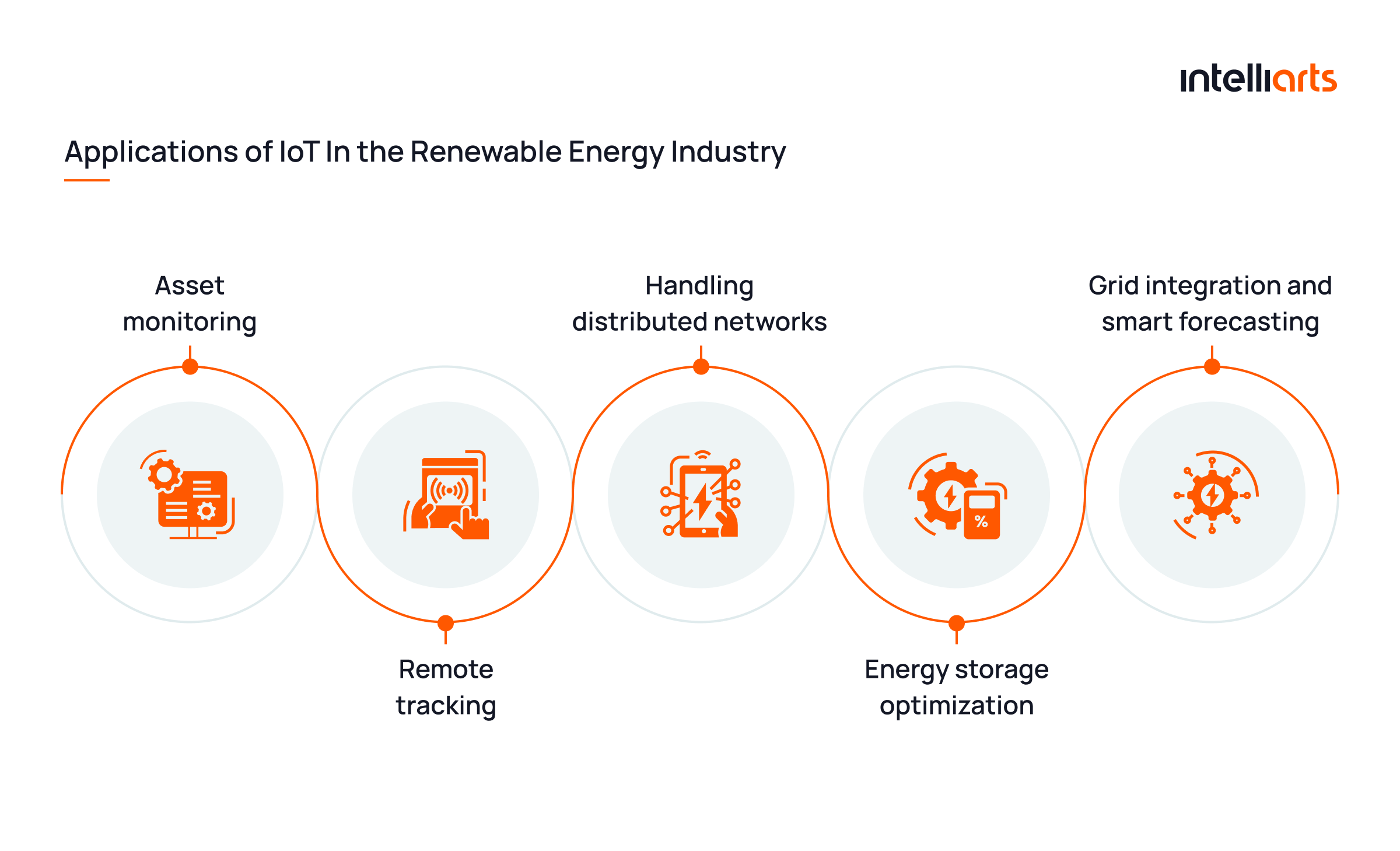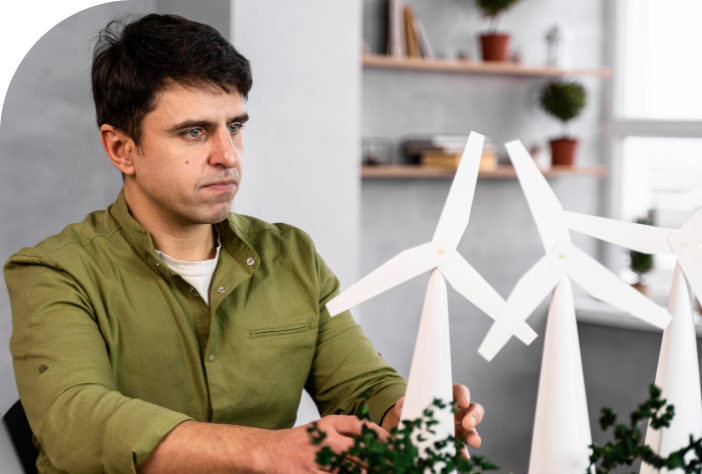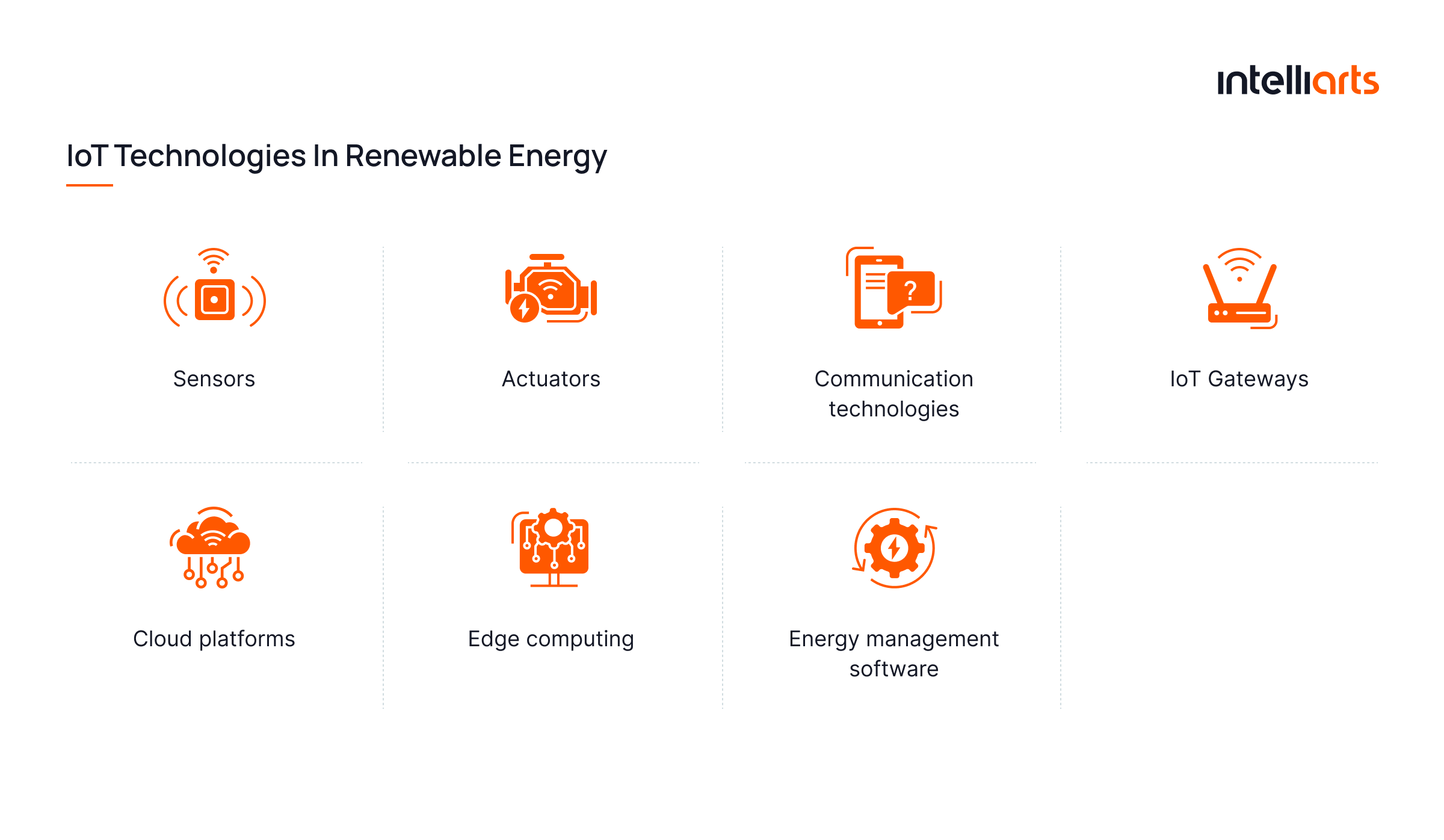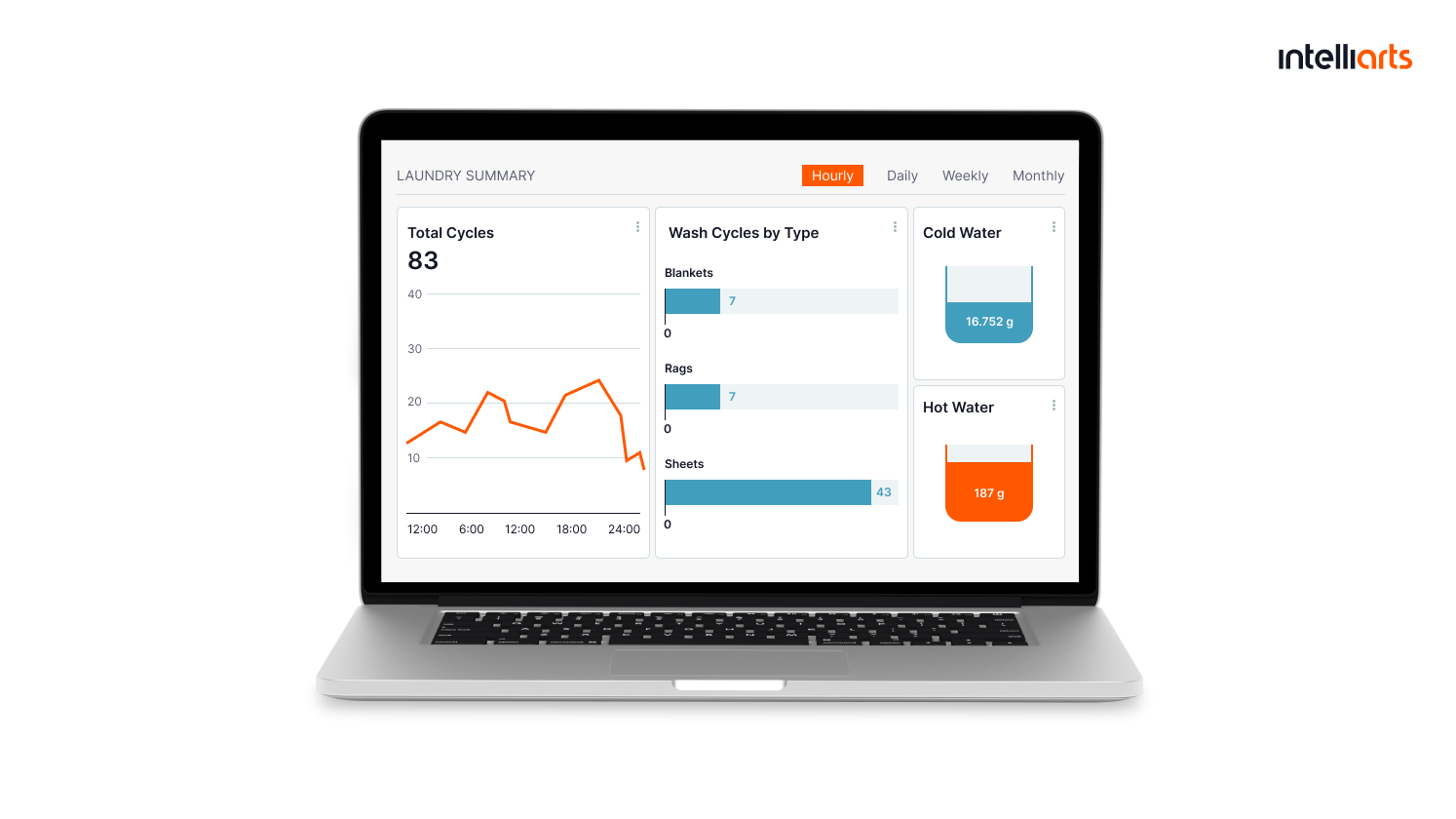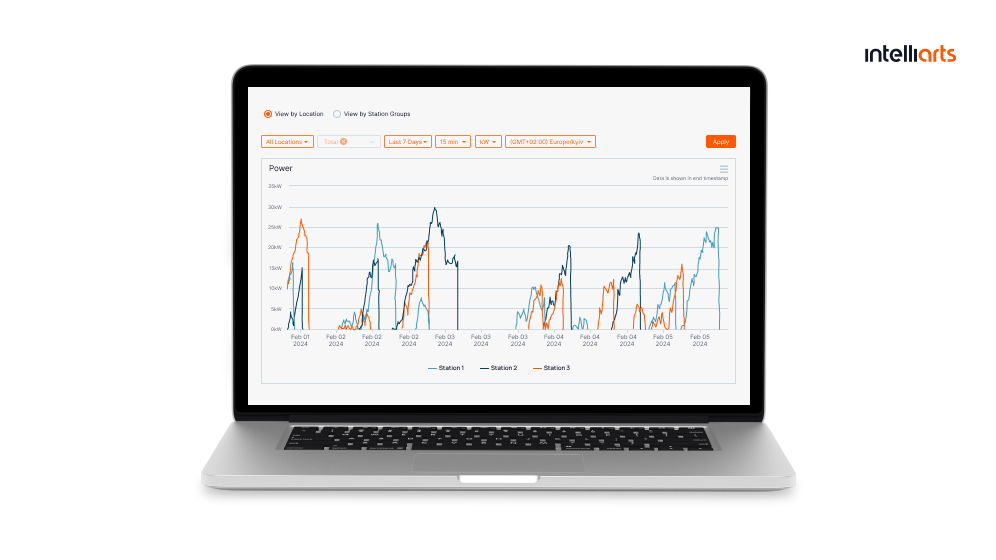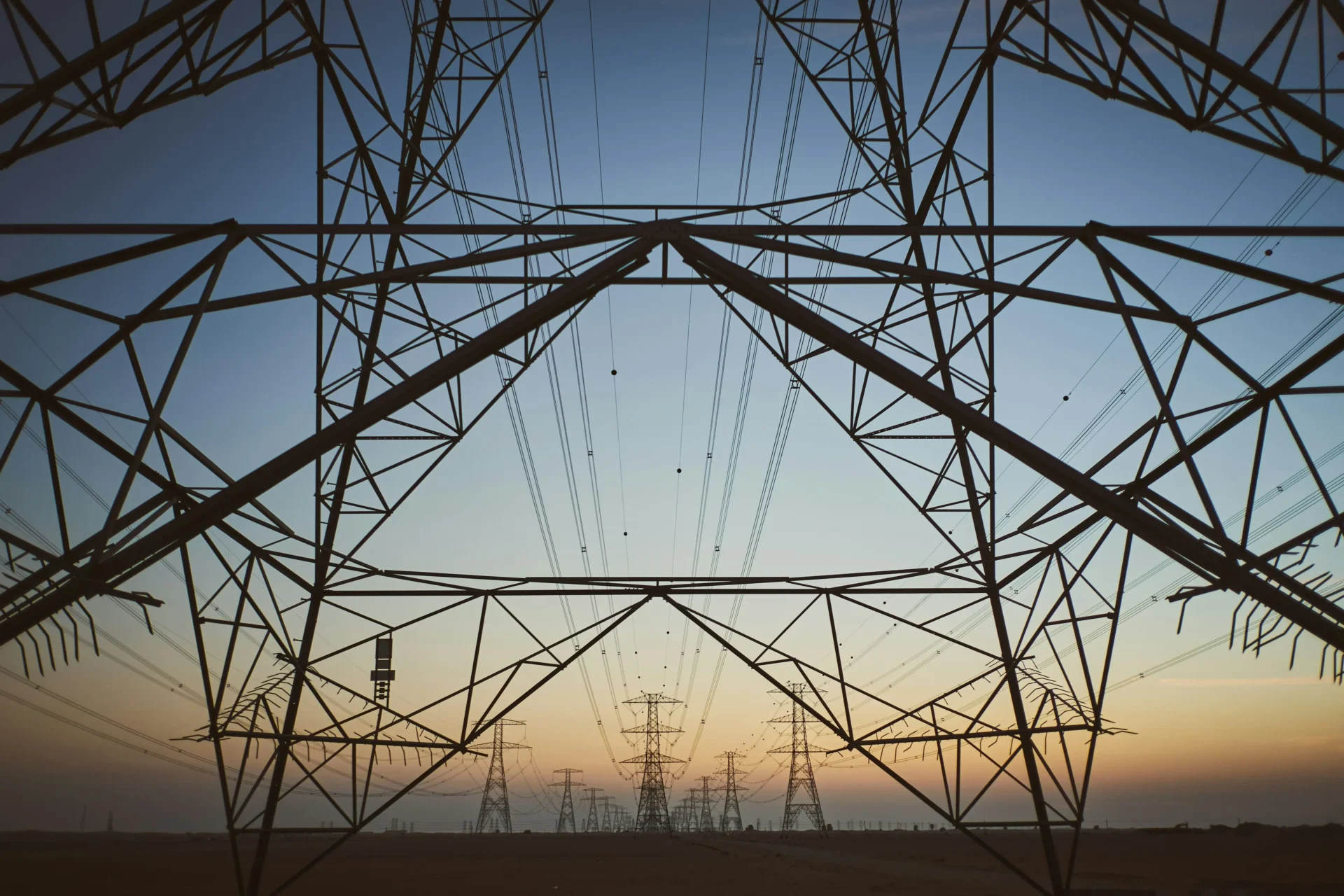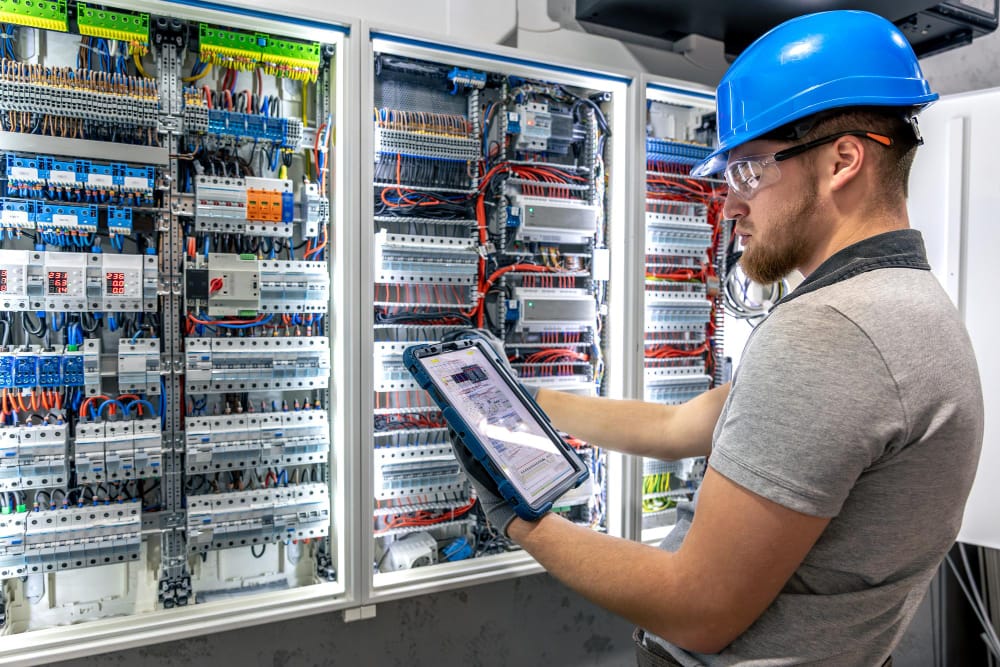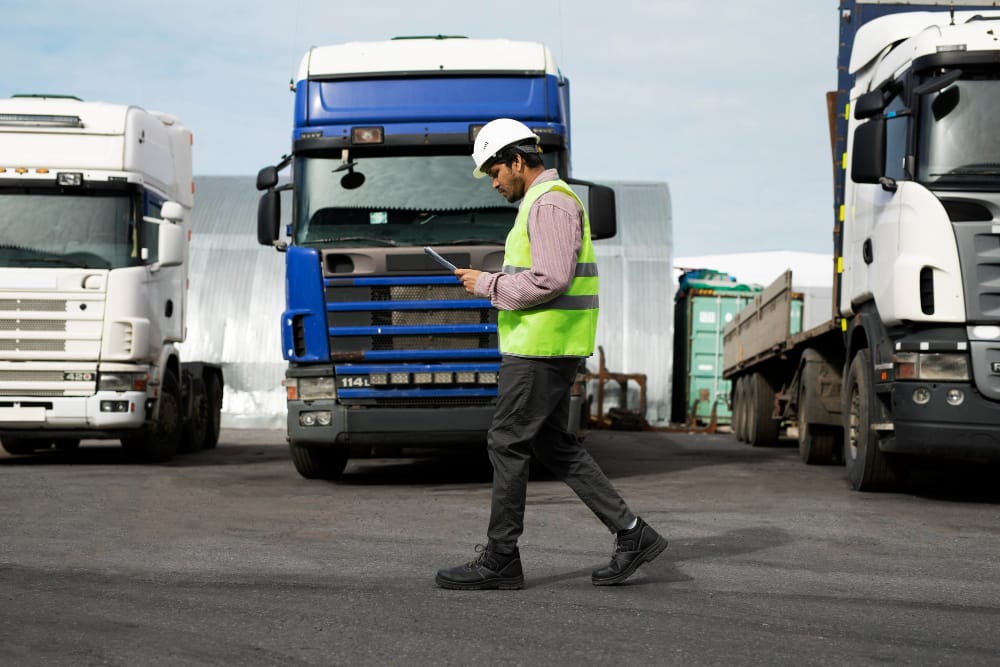The integration of the Internet of Things (IoT) in the renewable energy sector shows significant growth. Specifically, the IoT in the renewable energy segment is expected to expand from $12.7 billion in 2023 to $78.3 billion by 2032, reflecting a CAGR of 21.9%. What insights can be drawn from that? The adoption of smart technology can provide a substantial business boost if approached wisely.
In this post, you’ll explore applications of AI and IoT in renewable energy, review IoT technologies backing up the implementation in the niche, and examine the benefits of utilizing IoT solutions. Besides, you’ll obtain an overview of common Internet of Things and renewable energy challenges and discover some real-life success stories.
How IoT is used in the renewable energy sector
Without further ado, let’s dive right into the top 5 best ways to use IoT for the renewable energy sector:
#1 Asset monitoring
Using IoT for renewable energy assets is often focused on real-time data collection to monitor performance and environmental impact, as well as provide early failure detection. Regarding asset monitoring, sensors installed on wind turbines, solar panels, and hydro plants can track energy generation, detect overheating, and predict maintenance needs before failures occur. This application of IoT in renewable energy operations also improves asset longevity by preventing mechanical stress.
Business pain points addressed:
- High maintenance costs due to manual inspections
- Unexpected breakdowns leading to power disruptions
- Limited visibility into equipment performance in harsh environments
- Difficulty in predicting failures before they impact operations
#2 Remote tracking
Internet of Things for the renewable energy sector enables remote monitoring of energy production, transmission, and storage across multiple locations. This way, operators can access real-time analytics on turbine rotations, panel efficiency, or hydro flow rates from anywhere, reducing the need for on-site supervision. Drones equipped with renewable energy IoT solutions also scan solar farms and wind parks to detect performance issues.
Business pain points addressed:
- Inefficiencies due to manual site visits in remote areas
- Delays in detecting operational failures
- High labor costs for round-the-clock monitoring
- Poor scalability of monitoring systems for large-scale IoT energy solutions
#3 Handling distributed networks
Managing a decentralized energy infrastructure requires IoT strategies in renewable energy. IoT platforms integrate smart sensors, energy meters, and AI-driven analytics to balance power loads, manage grid fluctuations, and optimize energy flow across multiple renewable sources. This ensures stable grid integration without overloading storage systems.
Business pain points addressed:
- Grid instability due to fluctuating energy supply from renewables
- Challenges in distributing power across multiple locations
- Energy waste due to unoptimized load balancing
- Difficulty in integrating with legacy power grids
#4 Energy storage optimization
One of the biggest challenges in developing IoT solutions for renewable energy is ensuring efficient storage and utilization. Smart batteries powered by IoT energy solutions monitor charge cycles, prevent overloading, and use predictive analytics to store surplus energy for high-demand periods. IoT sensors also identify underperforming storage units before they fail.
Business pain points addressed:
- Energy loss due to inefficient storage
- Shortened battery lifespan from improper charge management
- Inability to store surplus energy for peak demand
- Lack of real-time data on battery health and efficiency
#5 Grid integration and smart forecasting
The future of IoT in renewable energy depends on smart forecasting powered by real-time weather data, historical energy consumption trends, and AI-driven demand predictions. These are all core elements of modern smart grid software development services designed to improve system reliability and resilience. IoT in renewable energy operations ensures better grid stability by predicting fluctuations and automatically adjusting energy distribution. This is particularly useful for wind and solar power, where energy output is weather-dependent.
Business pain points addressed:
- Unpredictable energy generation disrupting grid stability
- Over-reliance on fossil fuel backups during renewable energy shortages
- Inefficiency in forecasting demand fluctuations
- Difficulty in integrating intermittent renewable energy sources into the grid
You may discover more about IoT in smart grid systems in another blog post by Intelliarts.
IoT technologies in renewable energy
Among the hardware and technologies backing up renewable energy IoT solutions, the key ones are the following:
#1 Sensors
Devices that measure and collect data such as solar irradiance, wind speed, temperature, and energy output. They enable real-time monitoring of renewable energy systems for performance optimization and fault detection.
Examples:
- Apogee Instruments Pyranometers for measuring solar radiation.
- Vaisala WINDCAP Ultrasonic Anemometers for wind speed and direction monitoring.
#2 Actuators
Components that perform actions based on sensor inputs, such as adjusting solar panel angles or wind turbine blades to maximize energy production.
Examples:
- SMC Electric Actuators for precision control in solar tracking systems.
- Siemens Actuators used in wind turbine blade pitch control.
#3 Communication technologies
Protocols like LoRaWAN, Zigbee, and 5G facilitate seamless data transmission between IoT devices and cloud platforms, ensuring reliable connectivity across renewable energy systems.
Examples:
- Semtech LoRaWAN Modules for low-power, long-range communication in solar farms.
- Digi Zigbee RF Modules for wireless data transmission in energy monitoring systems.
#4 IoT Gateways
Devices that aggregate data from sensors and transmit it to cloud platforms for processing and analytics. They serve as the bridge between hardware and software in IoT systems.
Examples:
- Advantech IoT Gateways for industrial energy applications.
- Cisco IoT Gateways used in distributed renewable energy networks.
#5 Cloud platforms
Scalable solutions for storing, processing, and analyzing data from renewable energy IoT systems. They support advanced analytics, predictive maintenance, and system optimization.
Examples:
- AWS IoT Core for managing renewable energy data.
- Microsoft Azure IoT for scalable cloud analytics in renewable energy systems.
#6 Edge computing
Localized data processing technology that enables rapid decision-making and reduces dependence on cloud connectivity, especially in remote renewable energy installations.
Examples:
- NVIDIA Jetson Nano for edge AI applications in energy management.
- HPE Edgeline Systems designed for renewable energy IoT operations.
#7 Energy management software
Platforms designed to analyze IoT-generated data, optimize resource utilization, and monitor system health for better operational efficiency.
Examples:
- Schneider Electric EcoStruxure for renewable energy management.
- Enphase Enlighten software for monitoring and managing solar energy systems.
Looking for advice on IoT in renewable energy adoption? Explore how tech consulting can improve business efficiency in another blog post by Intelliarts.
Benefits of IoT solutions for renewable energy
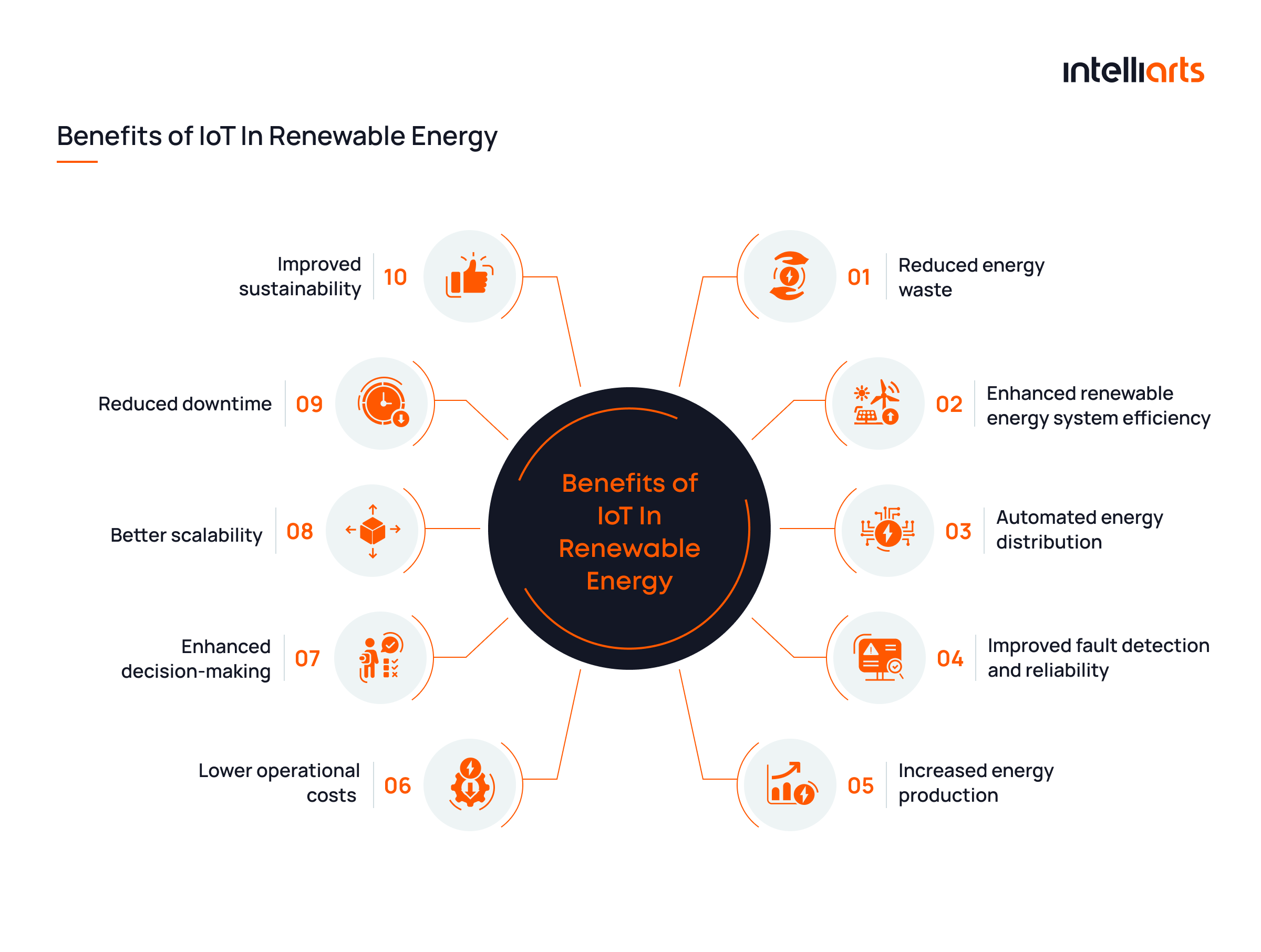
- Reduced energy waste: IoT sensors and smart meters monitor real-time energy use and production. This prevents overproduction or wasted energy flow. For example, solar energy systems to power IoT devices can be set to stop generating power when batteries are full.
- Enhanced renewable energy system efficiency: With IoT, companies can track important performance metrics like voltage, current, and temperature to optimize the operation of solar inverters or wind turbines. Again, this leads to more efficient energy use, even under unfavorable weather conditions.
- Automated energy distribution: A more balanced supply and demand is another advantage. One way to achieve this is by directing energy to where it’s most needed, for example, storage units or utilities like EV charging stations.
- Improved fault detection and reliability: By keeping an eye on equipment health and alerting operators about anomalies, such as overheating transformers or failing wind turbine blades, businesses can prevent system failures and make service more reliable.
- Increased energy production: IoT platforms can maximize energy output by looking at past weather patterns, optimizing solar panel placement, or adjusting turbine blade angles.
- Lower operational costs: IoT-based systems offer many ways of how to save operational costs, from remote monitoring to predictive maintenance. Both of these reduce the need for frequent on-site inspections, which cut down labor and maintenance expenses. For example, drones can inspect turbines in industrial wind farms when potential issues are detected.
- Enhanced decision-making: Data analytics powered by IoT gives insights into energy usage trends, equipment performance, and grid demand. All this information helps companies make better choices about load balancing, investments, or building a customized business solution.
- Better scalability: With modular IoT architectures, businesses can add new sensors, storage units, or renewable energy sources without much effort.
- Reduced downtime: Using predictive analytics, real-time alerts, and predictive maintenance, IoT systems can foresee and fix issues before they cause downtime.
- Improved sustainability: IoT contributes to sustainability goals by enabling clean energy production, smarter distribution, and efficient storage. Also, IoT systems can help you track and report emissions savings.
Challenges of implementing IoT applications in the renewable energy market
Every technology has its limitations that businesses should be mindful of. Let’s take a look as some common difficulties that interfere with the spread of applications of IoT in renewable energy:
- High upfront costs: The initial investment in IoT sensors, gateways, software, and skilled labor can be prohibitive for smaller clean energy companies. To address this, many turn to cost-sharing models or government subsidies. For example, government programs like the U.S. Department of Energy’s Smart Grid Grants provide funding to offset these costs.
- Data security and privacy concerns: IoT devices in smart energy systems generate vast amounts of sensitive data. Cyberattacks on critical infrastructure or breaches in data privacy can result in financial losses and regulatory penalties.
- Interoperability issues: Many IoT devices and software lack standardized protocols, making integration with existing renewable energy infrastructure difficult. This can hinder seamless communication between systems.
- Infrastructure limitations: Remote renewable energy installations often operate in areas with limited connectivity. This affects real-time data collection and control. Satellite communication and low-power wide-area networks (LPWANs) are emerging solutions.
- Scalability challenges: Scaling IoT systems to accommodate growing renewable energy deployments while maintaining efficiency and reliability is challenging. System upgrades and future-proofing need careful planning.
If you’re looking for support with application or solution development, our software engineering company is here to help.
What does the future of IoT in renewable energy look like?
While the above-mentioned IoT strategies in smart energy may already seem like a significant technology advancement, the best is yet to come. Let’s take a quick glance at three of the most innovative IoT applications that are expected to become commonplace in the future:
#1 Development of Virtual Power Plants (VPP).
It can be predicted that IoT will enable the creation of virtual power plants, i.e., networks of decentralized generation units by aggregating distributed energy resources. This approach is focused on enhancing grid reliability and enhancing the management of energy resources. Tesla is already launching VPPs in some regions, including Australia.
Discover more about Tesla’s VPP and its usage in the video below:
#2 AI-driven autonomous energy management
The question regarding the optimal usage of green energy is quite pressing. In the future, we will likely see AI-driven autonomous systems managing power distribution in real-time. AI will analyze data from IoT sensors to optimize energy generation, storage, and distribution without human intervention, reducing inefficiencies and stabilizing power grids. As such, Schneider Electric already offers solutions centered around resilient, AI-driven energy systems.
Explore how to balance load in power grids in another blog post of ours.
#3 Smart renewable energy trading via blockchain & IoT
With the rise of blockchain, IoT can now be paired with decentralized technologies that benefit consumer access to sustainable energy. As such, it’s possible to forecast that IoT will enable Peer-to-Peer (P2P) renewable energy trading through blockchain-based smart contracts. Households and businesses generating excess solar or wind energy can sell surplus power directly to consumers in real-time. Powerledger is one of the few companies, currently, which have already started leveraging blockchain for renewable energy.
Potentially, extensive adoption of innovations in IoT in renewable energy will result in a range of other beneficial technology applications.
Developing IoT renewable energy solutions with Intelliarts
Here are brief descriptions of several success stories of implementing IoT in renewable energy by Intelliarts:
IoT-driven platform for optimizing water and energy consumption
Challenge:
Xeros Technology, a pioneer in eco-friendly textile solutions, sought to develop an IoT-enabled platform to monitor and manage its fleet of water and energy-efficient washing machines. The goal was to track water and detergent usage, visualize cost savings, and provide advanced analytics to optimize resource consumption.
Solution:
Intelliarts developed Xeros Portal, an IoT-powered software solution that collects real-time data from connected washing machines. The system tracks water, detergent, and energy consumption, visualizing key insights through interactive dashboards. It also includes user management features for multi-role access control and API integration, enabling seamless fleet management and predictive maintenance.
Results:
Xeros’ machines now consume up to 70% less water, 50% less energy, and 50% less detergent, delivering significant cost savings and environmental benefits. The platform improved data-driven decision-making and early issue detection, reducing downtime and operational inefficiencies. By enhancing sustainability monitoring, Xeros strengthened its market position and helped businesses cut operational costs.
Optimizing energy consumption and reducing costs with IoT-driven power control
Challenge:
A leading EV charging provider sought to enhance its energy management capabilities by optimizing power distribution across its charging stations. The company needed a smart solution to minimize peak-hour expenses, comply with regulations, and provide a seamless charging experience for site hosts and EV drivers.
Solution:
Intelliarts developed a smart power management system that enables site hosts to schedule power limits for EV stations. The system dynamically adjusts energy distribution based on real-time electricity grid conditions, preventing overloads and reducing costs. The platform allows users to track energy usage, generate cost reports, and optimize off-peak charging schedules thanks to EV charging analytics.
Results:
The system successfully optimized energy consumption, reducing peak-hour demand and lowering electricity bills. API integration enabled automation for site hosts, eliminating manual adjustments. Compliance with UK smart charging regulations ensured stable grid performance, extending the lifespan of electrical infrastructure.
Final take
Incorporating IoT into renewable energy offers the ability to optimize energy storage and integrate it with power grids. From predictive maintenance to AI-driven energy management, these innovations enhance efficiency, reduce costs, and support sustainability. As emerging technologies gain popularity, the future of IoT in renewable energy promises even greater advancements. That’s why the best time to start investing in IoT-driven innovation is now.
Whether you’re building a predictive energy platform or an EV fleet monitoring tool, Intelliarts provides custom EV charging app development services that connect hardware, data, and users into seamless digital ecosystems.
Here at Intelliarts, with more than 24 years of experience on the market delivering on-demand developments, we are ready, willing, and able to execute your project end-to-end at the highest level of quality. Here are just a few reasons why to partner with us:
- Dedicated experts in your industry
- AI/ML skills
- Hands-on experience in IoT projects
- Scalability and future-proofing
- Continuous support and maintenance, etc
Should you need to integrate AI and IoT in renewable energy, consider partnering with an experienced software engineering company like Intelliarts.
FAQ
1. How can IoT help us reduce waste and improve efficiency for energy use?
IoT in renewable energy operations reduces waste by monitoring real-time consumption patterns and detecting inefficiencies in energy use. IoT devices optimize energy distribution, track system performance, and ensure minimal energy loss, making IoT solutions for energy essential for improving overall efficiency and sustainability.
2. How to maximize solar energy efficiency with IoT?
Using IoT for renewable energy like solar enhances efficiency through real-time monitoring of panel performance and environmental conditions. IoT devices detect inefficiencies, automate adjustments, and integrate weather forecasts to optimize output. Renewable energy IoT solutions ensure continuous system optimization for maximum solar energy production.
3. How IoT devices support renewable energy production?
IoT devices improve renewable energy production by enabling predictive maintenance, monitoring system performance, and automating operations. Applications of IoT in energy market include wind turbine monitoring, solar panel optimization, and efficient grid integration. The Internet of Things in energy sector ensures higher output with lower downtime.




